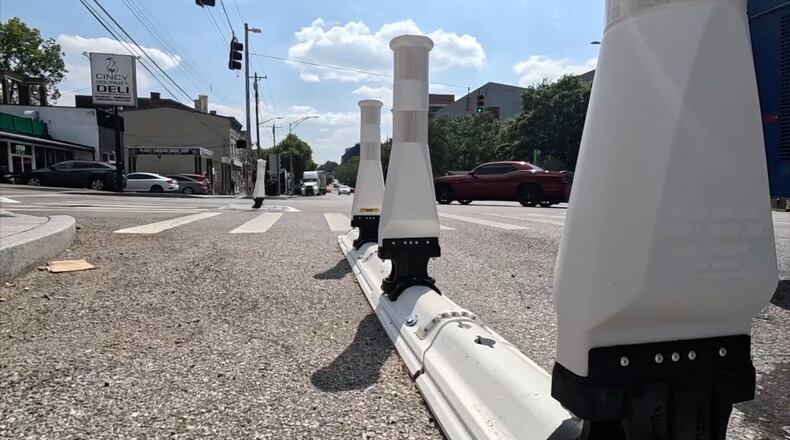Over the summer, the city’s Department of Transportation and Engineering installed eight “quick curb extensions” at various locations along Clifton Avenue, Jefferson Avenue and Martin Luther King Drive.
“I’m really excited to see these here,” said Bryce Mortera, a pharmacy student and lead for strategic partnerships at Civic Cincinnati, a local advocacy group.
On the corner of University Avenue and Jefferson Avenue, Mortera explained how the plastic bollards force vehicles to take wider turns, “hopefully decreasing blind spot[s] with people crossing.”
Previously, cars making a right turn from University to Jefferson could hit or drive onto the curb where pedestrians were standing.
It’s the same intersection where a student was killed after being hit by an SUV in September 2022. UC students rallied for pedestrian safety in the following months.
There’s also yellow bollards in the center of Jefferson to slow drivers in what is known as “centerline hardening.”
Moretera described it as a “scarecrow” that sends a message.
“This is somewhere you should go slower and not have as high of vehicle speeds,” he said.
The bollards are plastic, meaning they are designed to be temporary. Still, Mortera said it is a step in the right direction.
“They’re by no means a permanent solution, but it is a step in the right direction in showing that our advocacy and the city and institutions like the university are seeing that we want to have change in our infrastructure and really promote safety for everyone,” Mortera said.
In September, various crosswalks will be converted to zebra striping, the city manager said in a memo last week.
Later in the fall, nine concrete speed cushions will come to the major roadways around campus. They will be similar to the one installed throughout the city this spring.
The university will increase patrols at major intersections and crosswalks, said Jack Miner, vice president of enrollment management. Marked police cars will have their backlights on to warn drivers to reduce their speed. It will also serve as a visual reminder for students to use caution when crossing.
“You’ll notice that there’s a lot of construction around campus, so that’s one of the areas that we always worry about pedestrian safety the most,” Miner said, adding that the university has added increased attention and signage to those areas.
Education senior Zach Swinehart lives along Jefferson Avenue and crosses the road everyday to get to class. He said he’s watched cars travel “60 [miles per hour] easy.”
“It’s definitely not as bad as it used to be,” he said.
About the Author

